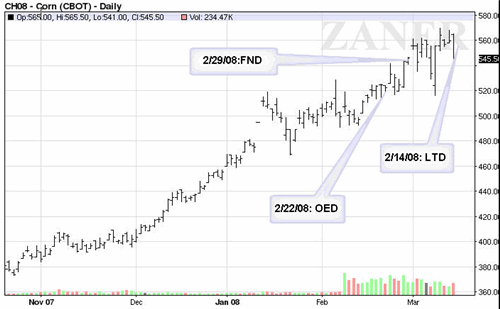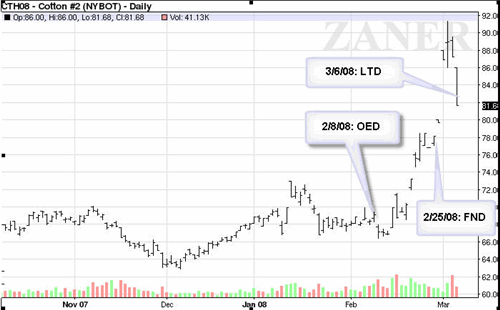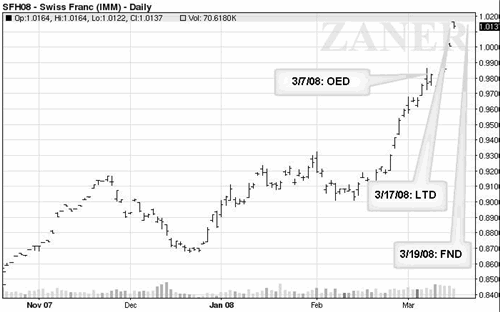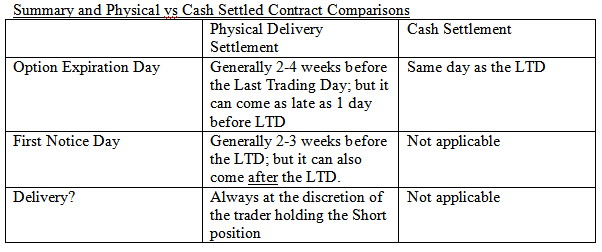Trading Opportunities in Non-Financial Futures Markets (Part 2)
NOTE: this article uses the term “financial futures” to include currencies, interest rates and stock indices.
Today, non-financial futures comprise only 20% of all U.S. futures trading volume. Nonetheless there are many exciting and vibrant markets to trade – both with outright long or short positions and with intra-market and inter-market spread positions. With virtually every contract trading on Globex or the ICE electronic platform, active scalping and day-trading is no longer just for floor traders but is readily open and available to anyone with a front-end order execution platform.
Are there differences in trading Corn vs. the S&P?
In some regards no. They are both futures contracts… not securities. Both have a Last Trading Day and trading is regulated by the CFTC. But there are subtle differences which can be gleaned by an examination of the contract specifications. These differences will affect the way these contracts move – which in turn requires an adjustment to the way you trade these contracts.
Several weeks ago we discussed three specific differences (see the bullet points in italics below). Today we will address Physical Delivery concerns and the issue of First Notice Day.
Traditional futures contracts vs. the e-minis and financials
– Fundamental vs. technical analysis
– Speed of news and special release dates
– Anticipatory markets and realization markets
– Physical delivery concerns and the issue of First Notice Day
– Storable commodities vs. nonstorable
– Carrying cost and spread relationships
– Volume and liquidity across the 24-hour trading day
– Day-trading vs. position trading
– Daily price limits and limit up/ limit down days
– Specialized managed futures programs
Not all physical commodity futures contracts have a physical delivery provision
First, let me clear up a misconception. Not all futures contracts based on an underlying physical commodity have a delivery provision. And not all futures contracts based on an underlying financial commodity are cash-settled.
To wit, feeder cattle and lean hogs are cash-settled, just like the S&P or Dow futures. No risk of ever owning or having to delivery the live animals. But woe to the trader who thinks that the US Dollar Index is cash-settled like the S&P. Hold a long or short position past the final trading day and you’ll wind up owning (or delivering) the actual six currencies which comprise the Dollar Index!
So today’s article is really more about the differences between physical delivery vs, cash-settled contracts.
The futures timeline
All physical delivery futures contracts (including bonds and currencies) have a timeline which is considerably different from cash-settled contracts. The timeline includes these important dates:
– Option Expiration Day
– First Notice Day (FND)
– First Delivery Day
– Last Trading Day (LTD)
– Last Delivery Day
The Option Expiration Day is just what it sounds like. Typically options will expire 2-4 weeks before the futures’ Last Trading Day. However the time between the last day you can exercise an option and the futures contract’s Last Trading Day can be as short as just 1 day, as is the case for natural gas. Most brokerage firms will exercise a long put or call position into a short or long futures position if the option is in-the-money by as little as 1 tick at the close of Option Expiration Day.
First Notice Day is critical for all speculators. It is the first day that shorts can make known their intention to make delivery, and thereby the earliest date that a long position can “get stopped” with a delivery notice. If you “receive delivery,” in effect your long futures position goes away and is replaced with a long cash position. There is an old but still very important rule of thumb for any speculator holding a long position: Liquidate ahead of the First Notice Day. The actual “rule” however can get a bit tricky.
For some contracts, such as the grains, Longs needs to be out of their position before the FND, to avoid any possibility of delivery. With cattle and pork bellies, you only need to be out before the closing bell on the First Notice Day. But now look at Sugar and Lumber. Here, the FND actually comes after the Last Trading Day.
So for these contracts, the more important “delivery-avoidance” day is the Last Trading Day, not the First Notice Day.
Where do these deliveries go?
Before I go any further, let me clean up another old myth. If you take delivery, no one dumps live cattle or soybeans in your front yard. In fact, more accurately, you take physical ownership.
The cotton might be in a Memphis warehouse and the silver locked away in a New York City depository. What you receive is a warehouse receipt evidencing ownership.
First Delivery Day and Last Delivery Day represents the date range in which the Shorts are permitted to make delivery (if they choose to do so). Using March corn as an example, someone holding a short position could have actually made delivery between March 3 and March 18. This is important for speculators to know, because this will affect their liability and risk management if a trader stayed long past the LTD. Stay long past the LTD and taking delivery is inevitable. But exactly when a trader would receive delivery can be anytime up through the Last Delivery Date.

Know the Contract’s Specs and Keep an Eye on the Calendar and the Clock!
The LTD for March corn is in March. The LTD for May coffee is in May. The LTD for June notes is in June. So when is the LTD for April crude oil? Not April, but in March (it was March 19, 2008 to be exact).
Woe to the hapless speculator who ignored the “contract specs” and maintained a position past the March 19 LTD. What was once a futures position in the April crude oil contract is now a long or short cash position!
Unfortunately the only rule for understanding this litany of dates is this: no one single rule can be applied! That’s right. When you begin to trade you must take the time to understand how.
And why did I mention keeping an eye on the clock? Because very often the closing bell for an expiring contract “rings” well before the usual closing time. Trading in expiring contracts closes at noon, Chicago time, on the Last Trading Day for CME Group meats, grains and treasuries. For any trader holding a position on the LTD, knowing the time of the final closing bell is crucial.



Larry Schneider is director of marketing and business development for Zaner Group, a futures and forex brokerage firm that offers platforms for self-directed traders and traditional broker-client full service for all futures markets and contracts, worldwide (www.zaner.com). Larry has spent over thirty years in the futures industry and has served on the National Futures Association’s Advisory Committee on Testing and Education since 1976.
